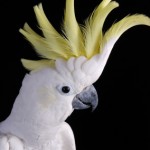It went viral. Millions of people have watched it. I posted links to three separate articles about it. It’s Snowball the dancing bird.
I listened to the following podcast this morning. Irena Schultz from NPR’s On Science did a more in-depth story on the science (and research) of dancing animals. To summarize:
- It seems that Snowball adapts his dancing patterns to the tempo, or speed, of the music. He listens to the beat, then picks which movement works best. For slower tempos, he sways side to side, whereas for faster songs he bobs his head up and down.
- Harvard psychology graduate students analyzed thousands of YouTube videos of dancing animals (birds, cats, dogs, elephants, etc.). They found 33 videos where it seems the animals were really dancing to a beat. Only 33 videos out of thousands? This may not seem like many, but it is significant given that a few short years ago scientists thought music was a uniquely human trait. The only animals who genuinely danced to the beat were parrots (14 diff
 erent species) and an elephant. According the researchers, what’s noteworthy about these animals is that they are vocal mimics. They, like humans, can imitate sounds.
erent species) and an elephant. According the researchers, what’s noteworthy about these animals is that they are vocal mimics. They, like humans, can imitate sounds. - These findings not only have implications for understanding how our brain processes music, but also can impact our understanding of musical development and of the origins of music. (For example, by blindfolding baby rats, researchers were able to understand visual development. Because of these studies, we now know how and when our visual system develops. We can do the same with music. We can study what happens to a parrot when he does not hear music early in life. We can study how that impacts the bird’s musical development, which may help scientists have a better understanding of human musical development.)
When I first heard about Snowball, I wondered whether this bird’s motor system somehow entrained to the beat. For anyone who has taken the Neurologic Music Therapy Training Institute, we know that there are subconscious links between our auditory system and our motor system. If we are walking down the street, singing a song to ourselves, we are walking to the beat of the song. Not on purpose, but automatically.
We use this principle when working with stroke victims and Parkinson’s patients. We can use rhythm to help re-train their motor systems, help them re-learn how to walk and talk again.
But I digress…regarding Snowball, I originally thought it might be entrainment. But speech? Vocal mimicry? That did not even cross my mind. I am so used to explaining about the subconscious, automatic connection between music and motor movement that I forget that sometimes we consciously move to music. We think about matching the beat. This is what Snowball seems to be doing. It seems to be a conscious (by “conscious” I mean corticol) process. Snowball would listen to the music, then determine which movement pattern was the best fit.
So the Harvard researchers have hypothesized that dancing may be a byproduct of the evolution of vocal learning. But that causes me to wonder: What is the purpose of dance? What is the purpose of moving to music? Is it related to the purpose for vocal mimicry?
Kids move to music naturally. When he was just shy of 1, my son began rocking side to side when he heard music, any kind of music. Dancing is also connected to our sex drive; we often use it as a way seduce members of the opposite sex. Of course, so do some birds. Have you ever watched BBC’s Planet Earth? Remember the mating rituals of some of the rainforest birds? They involved dance (though not to music).
I also wonder: was dancing ever used as a form of communication? I think of Native American pow-wows. I have never been to one myself and have only seen video footage. But dances have a purpose at pow-wows. Aren’t some of them used to tell a story?
So in modern times, dancing, or moving, to music has a variety of purposes. But which came first? How did it evolve? I don’t have the answers. Like the title says, these are just musings, are just thoughts and questions I am having after listening to and reading this information. Do you have any ideas?


 orcid.org/0000-0001-8665-1493
orcid.org/0000-0001-8665-1493






{ 2 comments… read them below or add one }
I think, much like speech, music and dance have been used for communication. Think about some of the tribal dances throughout the world. Not only were some used to please the gods, but also to communicate with others in the same (or competing) tribes as well as those in power. I like to think of those in the preliterate societies where information was passed down from one generation to another through dance and song.
Way to get me thinking, Kimberly!
You said that so much better than I did! I was wondering about using dance for communication, but could not think how to articulate it. Thank you, Ginny:)
You must log in to post a comment.